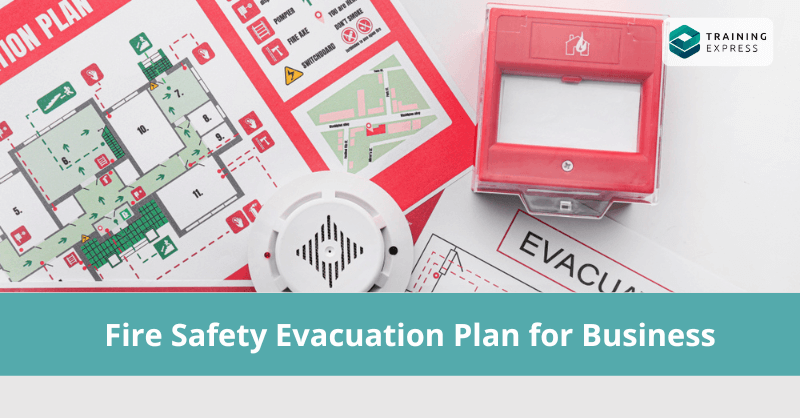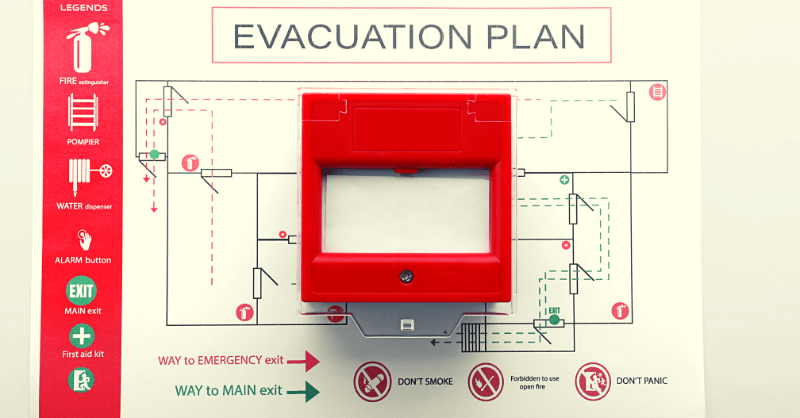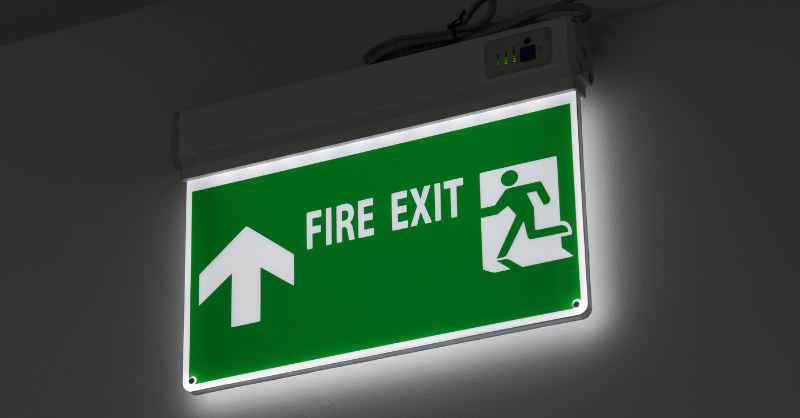

Fire devours everything in its way. It can be hazardous for both people and properties. Therefore, every business, institute, and residence must take necessary precautions to fight a fire. A fire evacuation plan is a significant step in reducing the casualties caused by fire.
Establishing a fire evacuation plan helps everyone evacuate the risk-prone area safely. In addition, a fire evacuation plan instructs people on what to do and what path to take if a fire breaks out.
Though people understand the necessity of a fire evacuation plan, many do not know how to create a plan for their businesses. This blog is here to help them out. It will provide an overall understanding of the fire safety plan. In addition, it will show what to incorporate and how to design the evacuation plan. So stick till the end!
Table of Contents
What is Fire Evacuation?
Fire evacuation refers to the process of evacuating people and animals from a fire breakout in order to prevent casualties. In the event of a fire, evacuation is the most common and essential health and safety procedure.
The fire execution starts with the sound of the fire alarm. People must follow the fire exit signs whenever they hear the alarm and get out of the building or premises. Every building must have a fire evacuation plan, including offices, schools, businesses, hospitals, and residences. It is mandatory to ensure the safety of the people living or working there.
What are the 3 Categories of Fire Evacuation?
Not all fire incidents are the same. Therefore, you can not apply the same fire evacuation plan everywhere. Keeping this in mind, 3 main categories of fire evacuation procedures were designed. These categories are –
1. Simultaneous Evacuation
2. Vertical or Horizontal Phased Evacuation
3. Silent Alarm Evacuation
These three categories of fire evacuation are described below –
1. Simultaneous Evacuation
The simultaneous evacuation system is the most common one among these three categories. As the name refers, this fire evacuation includes getting everyone out simultaneously as fast as possible from the building. This evacuation usually begins when the fire alarm starts. A fire safety marshal or a fire safety professional should lead the people to safety and ensure everyone is out of danger.
As everyone is leaving simultaneously, there is a good chance for the crowd to go out of control. People may start to panic and rush; it can take longer to evacuate the building. That is why it is very important that everyone is calm and in control for the evacuation to be successful.
2. Vertical or Horizontal Phased Evacuation
In the vertical evacuation, people evacuate through a stairway. This procedure requires everyone capable of using the stairway to exit the building as soon as possible. The process is conducted floor by floor. The floor where the fire broke out will be the first to evacuate. However, if the fire spreads upwards, there is a possibility that people may get trapped on the upper floors. That’s why the above floors are second in line to evacuate.

Horizontal evacuation is moving to an area which is considered safer and located on the same floor. There are special fire resistance compartments in buildings where horizontal evacuation is required. These compartments can provide safety till help comes or total evacuation is possible. Usually, hospitals, nursing homes etc., use horizontal evacuation as it is not easy to move the patients immediately.
3. Silent Alarm Evacuation
In silent alarm evacuation, the alarm is unlike the usual fire alarm. Instead, this alarm works as a code which the residents or the staff members can only understand. Usually, silent alarm evacuation is used in places with a possibility of mass panic.
For example, in shopping malls, with the sound of a fire alarm, all the people will rush to the exit. This will create a blockage, and people can also get injured. Along with that, this will take much longer to evacuate the location. Therefore, a silent alarm is used in such places. It allows the staff members to evacuate the premises without creating any chaos.
What is a Fire Evacuation Plan?
A fire evacuation plan is a document demonstrating the steps that should be taken by the residents or employees working in that particular building to reach safety in fire emergencies. The fire safety plan describes all the necessary actions in detail. Along with that, it also includes the process of calling the fire brigade in fire events.

There are two types of fire evacuation plans: general fire notice and staff fire notice.
The general fire safety notice is for comparatively more minor infrastructures. It contains the vital signs for fire safety evacuation. It is posted where everyone can read it and familiarise themselves with the signs.
Staff fire notice is for larger buildings or businesses. This notice provides more detailed information about the fire safety evacuation. In addition, the findings from the fire safety risk assessment are taken into account. Also, this notice gives proper instructions on what to do in case of a fire outbreak.
To ensure safety, the fire safety evacuation plan must be laid out properly. In addition, it is also important that each individual working or living in the building have an adequate understanding of the evacuation plan.
How to Create a Fire Evacuation Plan
for Your Business?
You are responsible for ensuring the safety of your employees. In order to provide safety to your employees and your customer, you should develop a fire evaluation plan. For creating a fire evacuation plan, you must consider the following factors.
Identify the Hazards
Before you develop a fire evacuation plan, you should examine the premises. By analysing the building, you can assess risk and identify potential hazards. This will help you take the essential steps to reduce the fire risk in your business.
After you examine the hazards, you should inform your employees about them. In addition, you should implement some rules to reduce the potential of a fire event. It is suggested that you take help from the fire safety professionals for the risk assessment and rule implementation.
Develop an Exit Route
After you have pointed out the potential risk, you have to develop an exit route. This route will help the customers and employees reach a safe location. When you design the route, you should keep a few factors in mind like the layout of your building, the exit points of the building, risk-prone areas etc. After you have developed the plan, make sure that your employees are informed about it.

Assign Roles
To make your fire evacuation plan effective, you should select a few employees who will play a key role in case of a fire outbreak. These employees will help everyone to clear out the premises calmly and without any delay. They will also ensure that everyone gets to safety.
Along with that, the selected individuals will check the fire safety plan on a regular basis. They must check if the alarm and fire equipment is working, and the evacuation route is clear.
Post Fire Evacuation Signs
One of the most important parts of your fire evacuation plan is to post fire safety signs in the right locations. These signs will help the staff and the customers find the exit route. In addition, the fire safety signs provide instruction on the action required in a fire emergency. While posting the signs, try to select locations which are easily visible.
However, putting up signs is not enough. Your employees must know what each symbol means. Otherwise, they will get confused and may end up in a dangerous situation. Therefore, you must educate your staff on the fire safety signs.
Related Article: Fire Safety Signs: The Ultimate Fire Safety Guide.
Actions on Hearing the Alarm
Your fire evacuation plan must instruct what actions are required when the alarm goes off. First, the plan must instruct on raising the alarm upon identifying fire. Then it should demonstrate what steps are required. For example, describing the procedure of calling the fire brigade.
Fire Fighting Equipment
In your evacuation plan, fire fighting equipment like fire extinguishers, fire hoses etc., should be incorporated. For example, a fire extinguisher can control small fires and prevent them from increasing. Hence, you should train your employees on how to use a fire extinguisher and identify the position of fire equipment in the evacuation plan.

Post the Fire Evacuation Plan
After you have completed your evacuation plan, you are supposed to put it up in different locations of the building. These locations have to be visible to everyone. However, you must explain the plan to your employees and clear out all their confusion and questions about the plan.
Personal Emergency Evacuation Plan
A Personal Emergency Evacuation Plan is for staff members who need assistance in evacuating. Usually, people with disabilities like mobility issues, hearing problems or the visually impaired require a personal emergency evacuation plan or PEEP. In your evacuation plan, incorporating PEEP is crucial for making sure each and every staff member is safe.
For developing the PEEP, you can conduct an assessment on different types and levels of disabled people working for you. This will help you take the essential measures to ensure everyone is safe. For example, you can use visual alarms or vibrating pagers for people with hearing disabilities. For people who have mobility issues and can’t climb stairs, you can assign another person to help them.
Practice Regularly
Your responsibility does not end with creating the plan. It is equally important to practice the evacuation plan. You should ensure that the employees frequently practice fire safety drills following the evacuation plan. It will help the staff develop a better understanding of the fire evacuation plan.
Besides, practising evacuation will bring out the errors in your plan. Thus, you will be able to modify and improve your evacuation plan.

What are the Dos and Don'ts of Fire Evacuation?
There are some things you must keep in mind when you are evacuating. It will help you in ensuring your own safety and others’ as well.
Do
- Ring the fire alarm using the nearest fire alarm if you are the first one to spot the fire.
- You should make sure that all the visitors evacuate from the premises.
- Get out of the building and go to the assembly point.
- Stay in the assembly point.
- Return to the building only if/when the authorised personnel allow you to.
Don’t
- Use the lift if it is included in the evacuation route or built as a safe location.
- Run while evacuating the premises. It will create chaos and lead to accidents.
- Return to the building to bring personal items.
- Take an attempt to fight the fire unless you are trained or certified to do so.
Summary
It is the responsibility of businesses to provide a safe work environment for the employees and the customer. Thus, creating a fire safety evacuation plan is mandatory for businesses. It will allow them to protect their employees and customers from injuries and even death.
Craft an effective fire safety evacuation plan for your business with a customised evacuation strategy for the office premises. Have a set of alarm systems with proper exit routes, signage, and equipment. Also, make sure to include an assembly point for everyone. Check the efficiency of your plan by requesting feedback from experts. And don’t forget to practice fire safety drills from time to time!
Apart from creating a plan for evacuating in case of a fire, it is crucial to conduct fire safety training sessions. Giving out Custom Keyrings containing fire safety details as a gesture of gratitude at the event can have a significant effect. These keychains serve as a practical tool for daily use while also serving as a reminder to stay aware of fire hazards.
Learn more from this Fire Safety Training Course and gain a recognised certification.
FAQ
What is Total Evacuation?
Total evacuation means moving all the occupants of the building to a safer location. Each and every individual exits the building and gathers in the safe zone.
What is the Correct Order of Evacuation?
If a fire breaks out, health and safety advice is to follow the ‘RACE procedure.’ It means –
- Rescue
- Alarm
- Contain
- Evacuate
In case of fire, rescue those in immediate danger, then sound the fire alarm. Then try to contain the fire and evacuate. Also, try to extinguish the fire if possible. And if total evacuation is necessary for a fire emergency, vertical evacuation is a priority. Followed by horizontal evacuation and then complete evacuation.
What does PEEP mean?
PEEP stands for Personal Emergency Evacuation Plan. The PEEP is an evacuation plan designed for someone with disabilities or mobility issues. Individuals with disabilities or mobility issues can’t follow the usual evacuation plan like others, so they require a specialised plan.
What Are My Fire Safety Duties as a Responsible Person?
As a responsible person, you have to take the initiative to ensure safety in the event of a fire. You have to prepare an evacuation plan considering the factors relating to the workplace and the people working there. In addition, you must conduct a fire risk assessment and incorporate the results into the evacuation plan.
However, your responsibilities do not end with the fire evacuation plan. You must review the risk assessment on a regular basis. In addition, you should inform the individuals about the fire hazards and install fire safety signs. It is also important that you explain the signs and fire safety measures to the staff. The best way to do that is by providing fire safety training.
- Available Courses
- Law10
- IT & Software225
- Design28
- Training6
- Accounting & Finance Primary48
- Teaching & Academics Primary36
- Teaching22
- Quality Licence Scheme Endorsed160
- Healthcare169
- Animal care10
- Job Ready Programme52
- Charity & Non-Profit Courses28
- HR & Leadership4
- Administration & Office Skills2
- Mandatory Training36
- Regulated Courses4
- Health and Safety520
- Marketing38
- Career Bundles201
- Construction59
- Electronics31
- Hospitality28
- Health and Social Care289
- Child Psychology40
- Management423
- Business Skills292
- First Aid73
- Employability283
- Safeguarding79
- Food Hygiene116
- Personal Development1597

 Food Hygiene
Food Hygiene Health & Safety
Health & Safety Safeguarding
Safeguarding First Aid
First Aid Business Skills
Business Skills Personal Development
Personal Development




